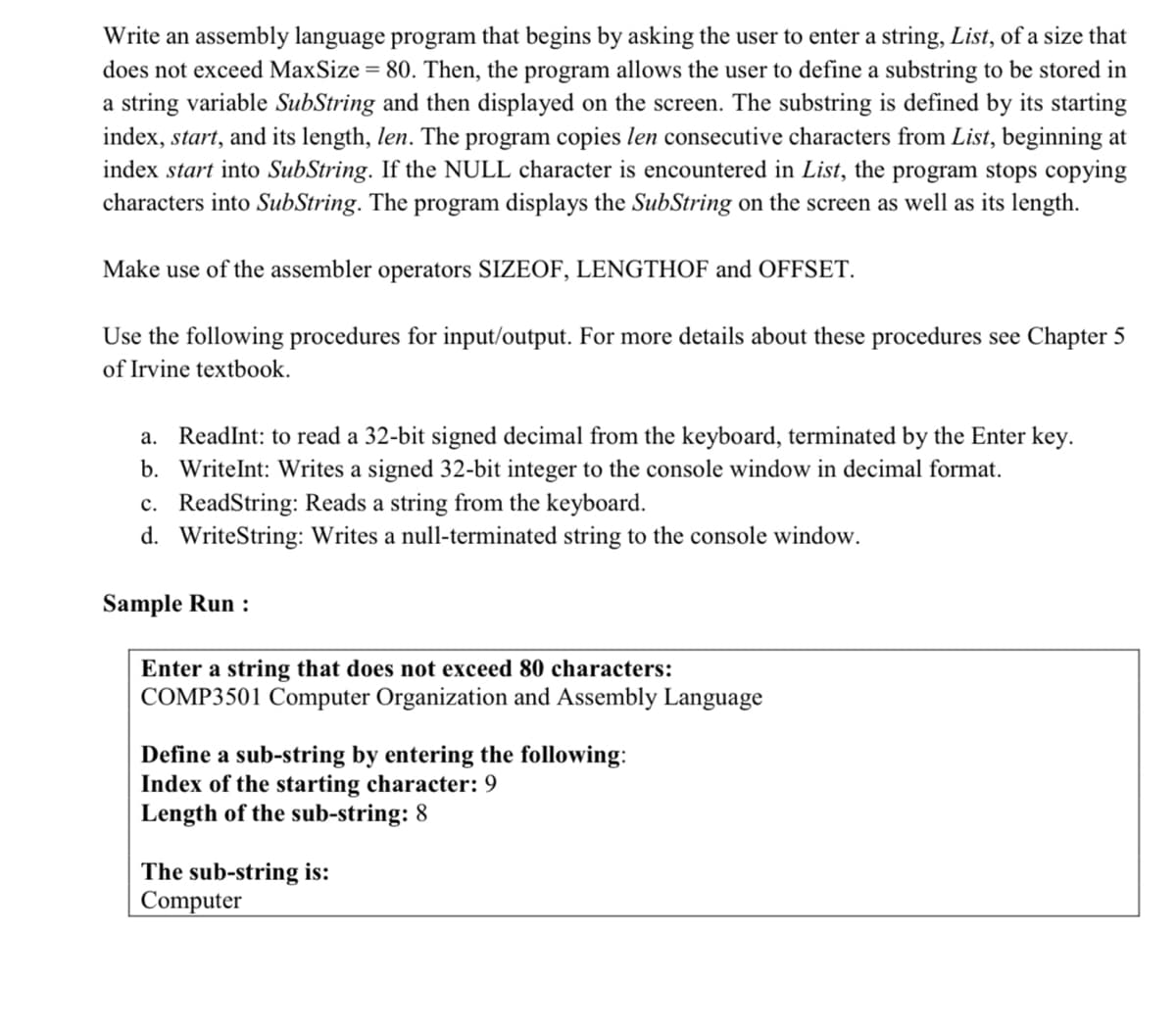assembly language
Computer Networking: A Top-Down Approach (7th Edition)
7th Edition
ISBN:9780133594140
Author:James Kurose, Keith Ross
Publisher:James Kurose, Keith Ross
Chapter1: Computer Networks And The Internet
Section: Chapter Questions
Problem R1RQ: What is the difference between a host and an end system? List several different types of end...
Related questions
Question
Write an assembly language program that begins by asking the user to enter a string, List, of a size that does not exceed MaxSize = 80. Then, the program allows the user to define a substring to be stored in a string variable SubString and then displayed on the screen. The substring is defined by its starting index, start, and its length, len. The program copies len consecutive characters from List, beginning at index start into SubString. If the NULL character is encountered in List, the program stops copying characters into SubString. The program displays the SubString on the screen as well as its length.
Make use of the assembler operators SIZEOF, LENGTHOF and OFFSET.
Use the following procedures for input/output. For more details about these procedures see Chapter 5 of Irvine textbook.
a. ReadInt: to read a 32-bit signed decimal from the keyboard, terminated by the Enter key.
b. WriteInt: Writes a signed 32-bit integer to the console window in decimal format.
c. ReadString: Reads a string from the keyboard.
d. WriteString: Writes a null-terminated string to the console window.
Sample Run :
Enter a string that does not exceed 80 characters:
COMP3501 Computer Organization and Assembly Language
Define a sub-string by entering the following: Index of the starting character: 9
Length of the sub-string: 8
The sub-string is:
Computer

Transcribed Image Text:Write an assembly language program that begins by asking the user to enter a string, List, of a size that
does not exceed MaxSize = 80. Then, the program allows the user to define a substring to be stored in
a string variable SubString and then displayed on the screen. The substring is defined by its starting
index, start, and its length, len. The program copies len consecutive characters from List, beginning at
index start into SubString. If the NULL character is encountered in List, the program stops copying
characters into SubString. The program displays the SubString on the screen as well as its length.
Make use of the assembler operators SIZEOF, LENGTHOF and OFFSET.
Use the following procedures for input/output. For more details about these procedures see Chapter 5
of Irvine textbook.
a. ReadInt: to read a 32-bit signed decimal from the keyboard, terminated by the Enter key.
b. WriteInt: Writes a signed 32-bit integer to the console window in decimal format.
c. ReadString: Reads a string from the keyboard.
d. WriteString: Writes a null-terminated string to the console window.
Sample Run :
Enter a string that does not exceed 80 characters:
COMP3501 Computer Organization and Assembly Language
Define a sub-string by entering the following:
Index of the starting character: 9
Length of the sub-string: 8
The sub-string is:
Computer
Expert Solution
This question has been solved!
Explore an expertly crafted, step-by-step solution for a thorough understanding of key concepts.
Step by step
Solved in 2 steps with 1 images

Recommended textbooks for you

Computer Networking: A Top-Down Approach (7th Edi…
Computer Engineering
ISBN:
9780133594140
Author:
James Kurose, Keith Ross
Publisher:
PEARSON

Computer Organization and Design MIPS Edition, Fi…
Computer Engineering
ISBN:
9780124077263
Author:
David A. Patterson, John L. Hennessy
Publisher:
Elsevier Science

Network+ Guide to Networks (MindTap Course List)
Computer Engineering
ISBN:
9781337569330
Author:
Jill West, Tamara Dean, Jean Andrews
Publisher:
Cengage Learning

Computer Networking: A Top-Down Approach (7th Edi…
Computer Engineering
ISBN:
9780133594140
Author:
James Kurose, Keith Ross
Publisher:
PEARSON

Computer Organization and Design MIPS Edition, Fi…
Computer Engineering
ISBN:
9780124077263
Author:
David A. Patterson, John L. Hennessy
Publisher:
Elsevier Science

Network+ Guide to Networks (MindTap Course List)
Computer Engineering
ISBN:
9781337569330
Author:
Jill West, Tamara Dean, Jean Andrews
Publisher:
Cengage Learning

Concepts of Database Management
Computer Engineering
ISBN:
9781337093422
Author:
Joy L. Starks, Philip J. Pratt, Mary Z. Last
Publisher:
Cengage Learning

Prelude to Programming
Computer Engineering
ISBN:
9780133750423
Author:
VENIT, Stewart
Publisher:
Pearson Education

Sc Business Data Communications and Networking, T…
Computer Engineering
ISBN:
9781119368830
Author:
FITZGERALD
Publisher:
WILEY